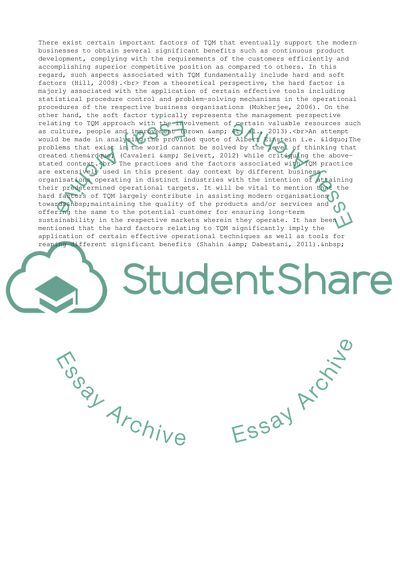CHECK THESE SAMPLES OF The Hard Factors of Total Quality Management
Research questions With reference to the hard factors of TQM, this research will try to establish how effectively GASCO utilizes these factors to achieve organizational performance.... hard factors of TQM IMPLEMENTATION IN THE PROJECT DIVISION AT GASCO Date Problems/Dilemmas and the solutions The end user determines most of the CTNs, and thus, any change takes place in accordance to the user requirements.... Further, since there are two types of TQM, the soft factors and the hard factors, this report hopes to establish the impact of proper use and application of the hard factors in an organizational setting....
3 Pages
(750 words)
Essay
total quality management (TQM) is a systemic approach to productivity enhancement using qualitative and quantitative methods and involving all stakeholders to continuously improve the quality of all products and services.... hellip; Thus it can be said that, total quality management is a strategy which is implemented by the management while aiming for implanting consciousness of quality in all managerial procedures.... Quality Focused Management Styles:total quality management has changed the traditional management style forever....
3 Pages
(750 words)
Essay
The researcher of this essay focuses on the analysis and discussion of the role of total quality management in the National Health Service provided by the United Kingdom to it's citizens and improvements in both the quality and efficiency with which health services are delivered today.... This essay intends to look at this developing importance of total quality management in the healthcare sector.... And using the NHS as a guide, this article reviews the critical elements of total quality management, the different factors that come to play in promoting these elements and how these can be better put to use to improve the overall quality of service delivery in the NHS....
10 Pages
(2500 words)
Essay
total quality management (TQM) is ‘an approach to improving the competitiveness, effectiveness and flexibility of a whole organization' (O'Neill & Sohal, 1999).... Although there have been modification to the adaptation of the TQM, the essential principles of this management philosophy remains the same.... As service expectation of the existing customers and potential customers have gone up, and as TQM is a management philosophy based on continuous improvement, Marriott felt the need to consider TQM in their company to be able to deliver quality service and to sustain their image in the competitive market....
10 Pages
(2500 words)
Essay
has implemented the approach of total quality management to guarantee the quality of our product.... Improvement cycles are encouraged and maintained for all the company's activities like product development and the proper management of customer relationships.... It was introduced and directed by top management where commitment, dedication and personal involvement has always been a top priority of theirs.... It was introduced and directed by top management where commitment, dedication and personal involvement has always been a top priority of theirs....
4 Pages
(1000 words)
Case Study
The total quality management is a separate discipline in the field of management which if implemented in the appropriate manner ensures productivity and desired results.... Whatever has been achieved by Apple Inc is the result of adherence to the total quality management.... has introduced new dimensions in the field of management and industry businesses and it has ended the old culture of dependencies on each other.... The first and foremost rule to achieving this feat is to create products and services… Since quality is a very subjective element and it varies between the industries and the customers....
5 Pages
(1250 words)
Term Paper
In management, there are various roles that ensure a company goes in the right direction.... Leadership and customers and production quality are all connected, and thus leaders should be carefully chosen (Bounds, 2004; 45).... How does this make effective quality assurance possible?... This brings the end product as a high-quality product that a customer is happy to use.... This action of team-play allows for contribution of effective quality...
5 Pages
(1250 words)
Assignment
This can be achieved in total quality management by ensuring that they have implemented changes in their production process that would lead to efficacy and deliverance of quality products and services.... uccessful companies ensure that they deliver quality products and services through emphasizing on improvement of factors of production.... rganizations ensure management processes are managed with required efficiency so as to offer quality… Training courses are also offered to the employees to equip them with best skills which allow them to offer quality work....
5 Pages
(1250 words)
Assignment


